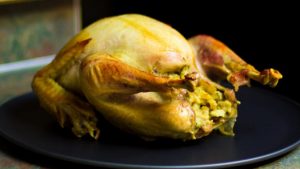I wrote the below for NC State News.
As a Canadian in the U.S. I’ve fully embraced the holiday season that runs from Thanksgiving through December. I enjoy spending a day planning and shopping for an event-style meal, and then another day actually preparing and cooking it. I throw on some tunes (this year it will probably be Drake, for my Canadian roots, and the Avett Brothers as a nod to North Carolina) and with the help of the rest of the family I’ll roast a turkey, make mashed potatoes, green beans, squash, beets and a couple of other harvest vegetables.
And we’ll make a lot of stuffing.
Depending on your preference and food persuasion there are lots of different stuffing or dressing options.
A common question that pops up is whether it’s better to cook stuffing it in the bird to preserve moisture (and get flavored by the turkey juices) or prepare it as a separate dish. The concern is that if someone puts the stuffing in the turkey cavity it may become contaminated by the turkey juices and Salmonella and Campylobacter will migrate through the stuffing. Easier to recommend not messing with the cross-contamination instead of managing the risk. But what does the science say?
I’m a food safety nerd and take a science-based approached to my meals. Armed with a digital, tip-sensitive thermometer I’m happy to jam stuffing up inside of my poultry and use the probe to check the temperature. And I use 165 degrees Fahrenheit as a target for my bread-based stuffing.
There’s some history to that number; in 1958 Raymond Rogers and Millard Gunderson of the Campbell Soup Company published some work evaluating the safety of roasting frozen stuffed turkeys (a new product at the time). Using a known amount of Salmonella pullorum, nine turkeys and some then-fancy ceramic thermocouples, they found that they could get an 8-log (or 99.999999%) reduction when the deepest part of the stuffing hit 160 degrees Fahrenheit. They recommended 165 degrees to be conservative (and because some thermometers aren’t always very accurate).
From the manuscript (comments that still apply today): “The initial temperature and the size of the turkey influence considerably the time required to reach a lethal temperature in the stuffing. The lower the initial temperature of the turkey, the longer the roasting period required. Present recommended roasting procedures designating hours cooking time or which stipulate a thigh or breast temperature to be attained alone does not appear to be adequate bacteriologically.”
Inside the bird, outside the bird; meat or no meat: Use a thermometer.
For your holiday viewing, here’s a video devoted to minimizing risk from foodborne illness when cooking turkey. More food safety tips are available here.
